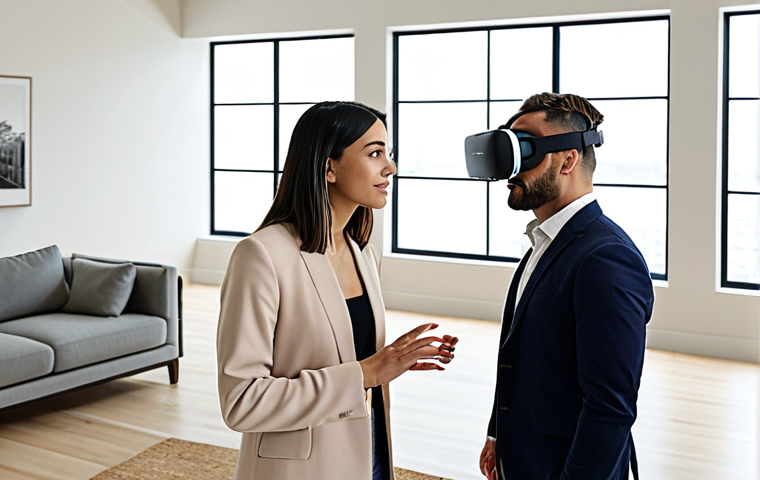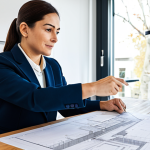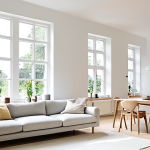There’s a unique thrill, and let’s be honest, often a profound challenge, in seeing an architectural vision come to life. But beyond the blueprints and beams, what truly defines a project’s success?
For me, after years in this field, it always boils down to one critical element: client satisfaction. It’s not just about delivering a structure; it’s about exceeding expectations, understanding their evolving needs, and perhaps most crucially in today’s fast-paced world, leveraging cutting-edge tools.
I’ve personally witnessed how integrating immersive VR walkthroughs or emphasizing sustainable practices from day one can transform a client’s experience from merely satisfactory to absolutely delighted.
As the industry pivots towards more intelligent, adaptive spaces, ensuring our clients feel heard, valued, and genuinely excited about their future building is paramount.
Let’s explore it precisely.
Mastering the Art of Deep Client Empathy

For any architectural project, true success isn’t just measured in the elegance of the design or the efficiency of construction; it’s profoundly rooted in how well we connect with our clients on a human level.
I’ve personally seen projects flounder, not due to technical issues, but because the initial client brief, however detailed, missed the deeper, unarticulated needs and aspirations.
It’s about moving beyond simply “what they want” to truly understanding “why they want it” and “how they envision their lives within that space.” This requires an almost anthropological approach, observing, listening between the lines, and asking the right questions that uncover their lifestyle, values, and even their long-term dreams for the space.
My team and I once spent a full day with a family at their current home before designing their new one, just to observe their routines, how they interacted with different rooms, and what truly frustrated or delighted them about their living situation.
That deep dive revealed a need for a quiet reading nook they never explicitly mentioned but clearly craved. It’s those subtle insights that turn a good design into an exceptional, life-enhancing one.
1. Beyond the Brief: Unearthing Unspoken Desires
It’s easy to stick to the checklist, isn’t it? “Three bedrooms, open-plan kitchen, south-facing windows.” But what really brings a project to life is delving into the layers beneath those initial requests.
I remember a client who initially asked for a “modern, minimalist” home. Through casual conversations over coffee, I learned about their passion for collecting antique books and hosting large, boisterous family dinners.
The minimalist brief, while valid, started to feel at odds with their true lifestyle. By gently probing and sharing examples of how modern design could still accommodate warmth and personal touches, we evolved the concept to include custom, integrated shelving for their books and a more adaptable dining space that could shrink for intimate meals and expand for grand gatherings.
It wasn’t about contradicting their initial brief but enriching it with what truly mattered to them, even if they hadn’t initially articulated it. This empathetic approach built an immense amount of trust, and the final home felt incredibly personal and authentic to them.
2. The Power of Active Listening and Iterative Feedback
Active listening isn’t just about hearing words; it’s about processing emotions, hesitations, and excitement. In architecture, this means allowing for ample time in meetings, not rushing the conversation, and providing easy avenues for clients to provide feedback throughout the design process.
I’ve found that early, frequent check-ins, even with rough sketches or simple 3D models, can prevent major overhauls down the line. We once had a client who was initially hesitant about a specific window placement.
Instead of pushing our design, we presented several alternatives, explained the pros and cons of each, and then *listened* intently to their nuanced reaction to each option.
It turned out their concern wasn’t about privacy, as we’d assumed, but about direct sunlight fading their antique rugs. This small detail, once understood, allowed us to adjust the window design with a subtle overhang, satisfying both aesthetics and their practical concern.
It’s an iterative dance, a constant back-and-forth that hones the vision until it aligns perfectly with the client’s innermost desires.
Leveraging Immersive Technology for Clarity and Confidence
In today’s architectural landscape, it’s almost criminal not to utilize the incredible technological advancements at our fingertips, especially when it comes to client communication.
Gone are the days when static blueprints and glossy renders were enough to convey the spatial experience of a building. Now, we have the power to literally transport clients into their future homes or workspaces long before a single brick is laid.
I remember the sheer awe on a client’s face when they first put on a VR headset and walked through their unbuilt luxury apartment. They could see the light falling just right in the living room, feel the scale of the kitchen island, and even envision where their favorite piece of art would hang.
This isn’t just a fancy gimmick; it’s a profound tool for building confidence, clarifying design decisions, and catching potential misalignments early.
It minimizes surprises and maximizes delight, transforming abstract concepts into tangible, explorable realities. This level of transparency makes clients feel incredibly involved and secure in their investment.
1. Virtual Reality Walkthroughs: Bridging the Imagination Gap
For years, one of the biggest challenges in architectural design was translating two-dimensional drawings into a three-dimensional understanding for clients.
People struggle to visualize space. VR walkthroughs have been a game-changer in this regard. I recall a major commercial project where the client was struggling to grasp the flow between the reception area and the main office space from traditional plans.
We created a detailed VR model, and within minutes of donning the headset, they “walked” through the proposed layout. Their immediate feedback was invaluable; they realized a corridor felt too narrow for the intended foot traffic, a detail that was impossible to discern from floor plans alone.
We made an immediate, cost-effective adjustment in the digital realm that would have been incredibly expensive and time-consuming if discovered during construction.
This technology doesn’t just show them the building; it lets them *feel* it, ensuring absolute clarity and preventing costly misunderstandings.
2. Dynamic 3D Modeling for Real-time Design Feedback
Beyond full VR, simply working with dynamic 3D models during client presentations can dramatically improve satisfaction. Instead of just showing pre-rendered images, being able to manipulate the model in real-time – changing materials, adjusting wall heights, or experimenting with window sizes on the fly – empowers clients to truly participate in the design process.
I love seeing a client’s eyes light up when I can instantly show them what their kitchen island would look like with a different countertop material, or how removing a wall could open up a space.
This direct, interactive feedback loop makes them feel heard and deeply involved. It’s a transparent process where they see their ideas taking shape instantaneously, leading to a much stronger sense of ownership and satisfaction with the final design.
It cuts down on endless rounds of revisions and builds a collaborative, creative atmosphere.
Prioritizing Sustainability as a Core Client Value
Sustainability is no longer a niche request; it’s a fundamental expectation for many, if not most, modern clients. What I’ve observed, however, is that client satisfaction doesn’t just come from *telling* them their building is sustainable; it comes from *showing* them the tangible benefits and involving them in the sustainable choices from the very beginning.
This means translating complex green building certifications into understandable personal impacts – like reduced energy bills, improved indoor air quality, or a smaller carbon footprint that aligns with their personal values.
I find immense satisfaction in educating clients about the long-term benefits, not just the upfront costs. For instance, explaining how a geothermal heating system, while initially pricier, will yield significant savings over the building’s lifespan and enhance their comfort creates a powerful connection.
It’s about building not just a structure, but a legacy of responsible living that resonates deeply with conscious consumers.
1. Educating on Long-Term Value and Environmental Impact
When discussing sustainable features, it’s crucial to go beyond buzzwords and provide concrete, understandable examples of their impact. I always break down the complex into digestible benefits.
For a client concerned about their carbon footprint, I might illustrate how solar panels would reduce their reliance on fossil fuels, or how rainwater harvesting would significantly lower their water bill and contribute to local conservation efforts.
I remember a conversation with a client who initially viewed green building as an “add-on cost.” By showing them a detailed projection of their energy savings over ten years with high-efficiency windows and insulation, alongside the positive impact on their comfort and a reduction in greenhouse gas emissions, their perspective completely shifted.
They didn’t just accept sustainability; they embraced it as a smart, responsible investment. This educational process transforms a simple transaction into a partnership aimed at a better future.
2. Integrating Health and Wellness into Design Choices
The concept of wellness in architecture has gained significant traction, and integrating it into design choices profoundly impacts client satisfaction.
Clients are increasingly aware of how their built environment affects their health, mood, and productivity. This goes beyond just fresh air; it includes maximizing natural light, selecting low-VOC (Volatile Organic Compound) materials, designing for optimal acoustics, and even incorporating biophilic elements like indoor plants or views of nature.
I worked on an office project where the client specifically requested a “healthy” workspace. We focused on circadian lighting systems that mimic natural light cycles, installed advanced air filtration, and designed break areas with access to natural elements.
Post-occupancy, the client reported a noticeable increase in employee well-being and productivity. This focus on human health, not just structural integrity, makes the building a true asset to those who inhabit it, leading to unparalleled client delight.
| Client Engagement Strategy | Impact on Satisfaction | Key Benefits & Examples |
|---|---|---|
| Deep Empathy Interviews | High: Reveals unspoken desires, builds strong trust. | Uncovers lifestyle needs (e.g., hidden reading nook), avoids costly late-stage changes. |
| Interactive 3D/VR Walkthroughs | Very High: Eliminates visualization gaps, boosts confidence. | Clients “feel” the space, identify flow issues early, less post-occupancy surprise. |
| Real-time Design Collaboration | High: Fosters ownership, speeds up decisions. | Instantly visualize material changes, adjust layouts on the fly, direct input. |
| Sustainability & Wellness Education | Moderate-High: Aligns with values, provides long-term value. | Lower utility bills, healthier indoor environment, contributes to positive social impact. |
Seamless Project Management and Transparent Communication
As an architect, I’ve come to realize that no matter how brilliant the design, a poorly managed project or opaque communication can quickly erode client satisfaction.
It’s not just about delivering the final product; it’s about the journey. Clients want to feel informed, in control, and confident that their investment is being handled with utmost professionalism.
This means establishing clear communication channels from day one, setting realistic expectations, and proactively addressing challenges before they become crises.
I’ve personally implemented weekly client updates, even if there’s “nothing new” to report, just to maintain that consistent touchpoint. It’s about building a relationship where they feel comfortable asking any question, knowing they’ll receive a prompt and honest answer.
This level of transparency not only reduces anxiety but also fosters a sense of partnership that makes the entire process more enjoyable for everyone involved.
1. Setting Clear Expectations from Day One
Misaligned expectations are a primary source of client dissatisfaction. From my own experience, it’s far better to be upfront about potential challenges, timelines, and budget realities than to sugarcoat them.
I spend considerable time during initial consultations outlining not just the exciting design possibilities but also the potential hurdles: regulatory approvals, unexpected site conditions, or the typical ebbs and flows of a construction schedule.
For one complex urban infill project, I spent an entire meeting detailing the permitting process unique to that city, complete with a realistic timeline.
The client appreciated the honesty, and when minor delays inevitably occurred, they were already mentally prepared, significantly reducing their stress and frustration.
This transparency builds a foundation of trust that is invaluable when navigating the inevitable complexities of a large project.
2. Proactive Problem-Solving and Regular Updates
It’s tempting to hide problems, hoping they’ll resolve themselves, but that’s a recipe for disaster. From my perspective, a hallmark of excellent project management is anticipating issues and communicating them proactively to the client with proposed solutions.
We once encountered an unforeseen bedrock formation during excavation that would impact the foundation design. Instead of waiting, I immediately informed the client, presented two viable alternative solutions with their respective cost and timeline implications, and recommended the most efficient path forward.
They weren’t thrilled about the additional cost, naturally, but their appreciation for our transparency and swift action far outweighed their disappointment.
Regular, concise updates, even short emails stating “No new major developments, all on schedule,” can dramatically reduce client anxiety and demonstrate a commitment to their peace of mind.
Crafting Spaces that Foster Well-being and Productivity
Beyond the aesthetics and functionality, modern architectural design is increasingly focused on how spaces impact the emotional and physical well-being of their occupants.
For me, client satisfaction reaches its peak when they inhabit a space that not only looks stunning but also actively enhances their daily lives. This involves a holistic approach, considering everything from natural light and ventilation to acoustic comfort and the psychological impact of colors and materials.
I’ve seen firsthand how a thoughtfully designed workspace, bathed in natural light and featuring elements of biophilia, can transform employee morale and productivity.
It’s about designing environments that nourish the soul and support human flourishing, making the client’s investment truly worthwhile. This focus on the human experience elevates architecture from mere construction to a form of art that genuinely improves lives.
1. Biophilic Design: Connecting Occupants with Nature
The power of nature within a built environment is undeniable, and clients increasingly seek this connection. Biophilic design, which integrates natural elements and patterns into architecture, has a profound impact on well-being and, consequently, client satisfaction.
I remember a residential project where the client, a busy executive, expressed a desire for a “sanctuary.” We focused on maximizing views of their existing garden, incorporating indoor plants, and using natural materials like wood and stone extensively.
The key was not just adding plants but designing the entire space to feel like an extension of the outdoors. Post-completion, the client frequently commented on feeling more relaxed and less stressed at home.
They found genuine solace in the subtle presence of nature throughout their living spaces, a satisfaction that went far beyond mere visual appeal.
2. The Science of Comfort: Lighting, Acoustics, and Air Quality
While often unseen, the “invisible” elements of design—lighting, acoustics, and air quality—are absolutely critical to client comfort and satisfaction.
A beautifully designed space can become unbearable if it’s too noisy, poorly lit, or has stale air. I’ve made it a point to educate clients on the long-term benefits of investing in these aspects.
For instance, explaining how high-quality windows reduce external noise and improve thermal comfort, or how advanced HVAC systems ensure optimal air circulation and filtration.
On one project, we installed specialized acoustic panels in a large open-plan office, a feature the client initially questioned as an added cost. After occupancy, they received overwhelmingly positive feedback from employees about the improved concentration and reduced stress levels.
It underscored that true comfort isn’t always glamorous, but it’s profoundly impactful on daily experience and, ultimately, client happiness.
Post-Occupancy Support and Long-Term Partnership
My commitment to client satisfaction doesn’t end when the construction dust settles and the keys are handed over. In fact, that’s often when a new phase of our partnership begins.
Offering robust post-occupancy support is, in my experience, a critical differentiator that fosters enduring loyalty and turns clients into enthusiastic advocates.
It’s about ensuring they transition smoothly into their new space, addressing any teething problems, and remaining a trusted resource for future needs.
I vividly recall a client who called me six months after moving into their new home, unsure how to operate a specific smart home system feature we’d installed.
Instead of simply directing them to a manual, I arranged a quick follow-up visit to walk them through it. That small gesture of continued support made a significant impression, reinforcing their trust in our firm and ensuring they felt completely comfortable and confident in their new environment.
1. Follow-up and Addressing Initial Adjustments
Even the most meticulously designed and constructed buildings require a period of adjustment for their occupants. Proactive follow-up is essential during this phase.
I typically schedule a check-in call or visit a few weeks after handover to see how they’re settling in and if they have any questions or minor issues.
It’s during these conversations that small operational quirks might emerge – a light switch that’s not intuitive, an appliance setting that’s confusing, or a question about maintenance.
By addressing these minor adjustments promptly, we prevent them from festering into larger frustrations. This demonstrates our ongoing care and commitment, showing that our relationship extends beyond the transaction.
It’s a simple yet powerful way to solidify satisfaction and ensure the client feels fully supported.
2. Becoming a Trusted Advisor for Future Needs
A truly satisfied client isn’t just someone who loves their new building; it’s someone who sees you as their long-term architectural partner. By providing excellent post-occupancy support, we position ourselves as trusted advisors for any future needs, whether it’s a small renovation, an extension, or even just advice on maintaining their property.
I’ve had clients call me years later for referrals for landscape architects or interior designers, simply because they valued our initial working relationship so highly.
This transition from a project-specific service provider to a long-term consultant is the ultimate testament to sustained client satisfaction. It’s about cultivating a relationship built on trust, expertise, and a genuine commitment to their evolving needs, ensuring that when they think “architecture,” they think of us.
Closing Thoughts
Ultimately, architectural success isn’t just about constructing buildings; it’s about building relationships, trust, and spaces that genuinely enrich lives.
From the initial empathetic deep dive into a client’s world to leveraging cutting-edge technology for clarity, and from prioritizing sustainable practices to offering unwavering post-occupancy support, every step in our process is designed to maximize satisfaction.
It’s a holistic commitment to understanding, collaborating, and delivering not just a structure, but a profound improvement in how people live, work, and thrive.
This dedication transforms a project into a partnership, and a house into a truly cherished home or an inspiring workplace.
Useful Information
1. Prepare Your Vision Board: Before meeting an architect, gather images, articles, and even sounds that inspire you. This helps translate abstract desires into concrete ideas for your design team.
2. Ask About the Design Process: Understand your architect’s typical phases, from conceptualization to construction administration. This transparency helps manage expectations and keeps you informed every step of the way.
3. Prioritize Your Non-Negotiables: Identify what truly matters most to you – whether it’s a specific aesthetic, energy efficiency, or a unique functional requirement. Communicating these early ensures they become central to the design.
4. Explore Sustainable Options: Even small sustainable choices, like efficient lighting or water-saving fixtures, can have a significant long-term impact on your utility bills and the environment. Discuss these with your architect.
5. Budget for the Unexpected: Large projects often encounter unforeseen challenges. Building a contingency fund into your budget (typically 10-15%) can prevent stress and keep the project on track if minor adjustments are needed.
Key Takeaways
Client satisfaction in architecture is cultivated through deep empathy, understanding unspoken needs, leveraging immersive technology for clear communication, integrating sustainability and wellness as core values, ensuring transparent project management, and providing consistent post-occupancy support.
It’s about building lasting relationships and creating spaces that truly enhance occupants’ lives.
Frequently Asked Questions (FAQ) 📖
Q: How do advanced tools like immersive VR walkthroughs truly elevate client satisfaction beyond traditional methods?
A: Oh, this is where the magic happens! I’ve seen it firsthand, countless times. You can talk about floor plans and renders all day, but when a client puts on that VR headset and suddenly they’re standing inside their future living room, walking through their kitchen, looking out the virtual window at their actual view – it’s an absolute game-changer.
I remember one particular couple, quite detail-oriented, who were initially hesitant about a specific kitchen layout. We’d modeled it carefully, but it wasn’t clicking for them.
Then, in VR, they could feel the flow, visualize placing their furniture, even see how the light would hit at different times of day. Their eyes lit up!
They immediately said, “Okay, now we get it, this is perfect.” That kind of immediate, experiential understanding saves so much time, prevents costly changes down the line, and most importantly, it transforms abstract drawings into a tangible, emotional connection to their future space.
They go from approving a design to genuinely anticipating moving in.
Q: Beyond the initial build, why is emphasizing evolving needs and sustainable practices from day one so critical for long-term client satisfaction?
A: It’s about building for life, not just for now. I’ve seen too many projects where short-sighted decisions haunt clients years later. When we talk about evolving needs, it’s about anticipating changes in their family dynamics, their business growth, or even their lifestyle.
For instance, designing flexible spaces that can easily convert from a nursery to a home office, or office layouts that can scale up or down without massive renovations.
On the sustainability front, it’s not just a buzzword; it’s a financial and environmental imperative. I remember working with a business owner who was initially skeptical about the upfront investment in geothermal heating and superior insulation.
But fast forward five years, and he called me, genuinely thrilled, because his energy bills were a fraction of his competitors’, and his employees loved the consistent comfort.
He ended up saving hundreds of thousands over the decade and it significantly boosted his company’s green image. It’s about future-proofing their investment and their peace of mind, demonstrating that we’re thinking about their success not just today, but decades down the line.
That foresight is incredibly valued.
Q: In such a technical field, how do you ensure clients feel genuinely “heard, valued, and excited” about their building vision?
A: This, for me, is the true art of it – it’s less about blueprints and more about empathy. It’s not enough to just listen; you have to hear what they’re not saying.
I’ve had clients walk in with a vague idea, maybe just a feeling they want to evoke, and it’s my job to dig deep, ask the right questions, and sometimes even challenge their initial thoughts gently to get to the core of their desire.
I recall one client who initially insisted on a very traditional design, but through our conversations, I sensed a deep-seated longing for something more modern and open.
It was about creating a space that truly reflected them, not just some Pinterest board. We went through several iterations, lots of discussions, and some moments of creative tension, but by the end, they felt like the design was a pure extension of their personality.
Seeing their faces light up during the final walkthrough, not just with satisfaction but with genuine excitement and a touch of disbelief that their dream was real – that’s the payoff.
It’s about being a partner, a guide, and sometimes, a bit of a dream translator, making sure every choice feels truly theirs.
📚 References
Wikipedia Encyclopedia
구글 검색 결과
구글 검색 결과
구글 검색 결과
구글 검색 결과
구글 검색 결과




